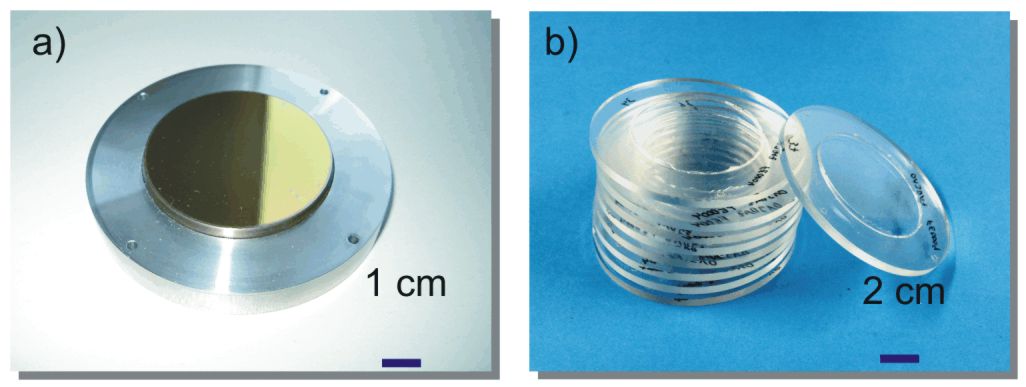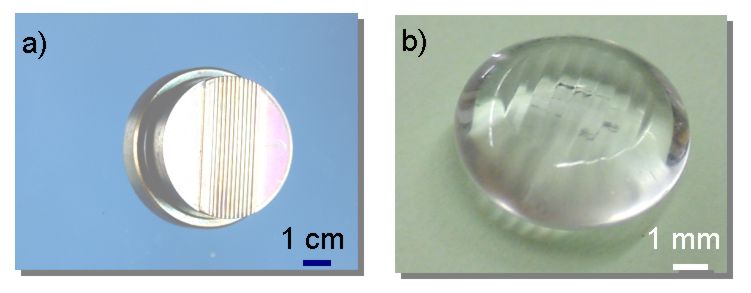Development of machinable sol-gel thin films
Sub-project H2
Development of machinable sol-gel coatings for high quality molds with optical surfaces
Principal investigators: Dr.-Ing. A. Mehner, Prof. Dr.-Ing. H.-W. Zoch
This work is part of our Germany-USA Transregional Collaborative Research Center on the Replication of Complex Optics.
Motivation
The high precision machining of free-form optical components with suitable surface finish can be successfully performed using diamond tools to machine copper, aluminum or nickel-phosphor coated substrates. Steel is difficult to machine because of high chemical reactivity between the steel and the diamond tool. Because of low hardness and wear resistance, copper and aluminum are not suitable as mold materials. The temperature resistance of nickel-phosphor coatings is too low (180°C) for the pressing of glass components.
Main Objective
-
Sol-gel process
The aim of the project H2 is to develop new types of sol-gel ceramic and organo-ceramic films that are able to be diamond-machined. High temperature steel used for molding tools will be coated. The deposition process of metalo-organic polymerdispersion (sol) is performed with dip- or spin-coating. With drying the liquid sol is transformed into a diamond-machinable gel-film. The organic components will evaporate with a heat-treatment of more than 400°C producing a film in a ceramic state. -
Properties
The coatings need to have good adhesion to the substrate, high hardness and wear resistance and temperature resistance up to 250°C for the plastic molds and up to 700°C for glass pressing. Good surface quality and machinability require a homogeneous microstructure with fine crystallites or amorphous material without significant porosity or defects. To be able to create structures, the films should have a thickness between 5 to 25 µm.
Results
-
Ceramic ZrO2-coatings
During the first period, thin hard oxid-ceramic ZrO2 films were deposited on steel molds. These films were examined and the mechanical properties were measured. The coated molds were also used in projects R1 (plastic injection molding) and R2 (glass pressing). As shown in Figs. 1 and 2, such films are suitable for the forming of plastic or glass. Diamond-machining of these films is currently difficult in the ceramic or pre-ceramic state. These difficulties are caused by insufficient film thickness, about 2 µm, and significant brittleness.
Fig. 1: Sol-gel-ZrO2-coated molds (left) and produced plastic lenses (right). 
Fig. 2: Coated glass pressing tool (left) and a produced cylinder lens array (right). -
Organically MOdified SILanes (ORMOSILs) coatings
Parallel to the development ZrO2 films, ceramic-organic nanocomposite coatings were developed based on ORMOSILs (organically modified silicates). A film thickness from 5 to 20 µm is achievable and it is possible to diamond machine and to structure the film (H3). However, the coatings at present have low hardness and temperature resistance (M3, M4). With the development of a special Ormosil-silicate coating type, it is possible to get a 700°C temperature resistant film without the presence of cracks and defects with a film thickness of 5 µm and appropriate hardness.
Fig. 3: a) schematic structure a ZTP/MATMS nanocomposite,
b) variation of the film thickness as a function of the spinning velocity,
c) microscopic picture of a diamond structured ZTP/MATMS film.
Future Work
The aim of the next research phase is to combine the high hardness and temperature resistance of ceramic ZrO2 films with the film thickness and machinability of Ormosil coatings and then to deposit diamond machinable sol-gel-films (5 to 25 µm thick) with high hardness and temperature resistance for the coatings of molding tools for plastic injection and glass pressing.

